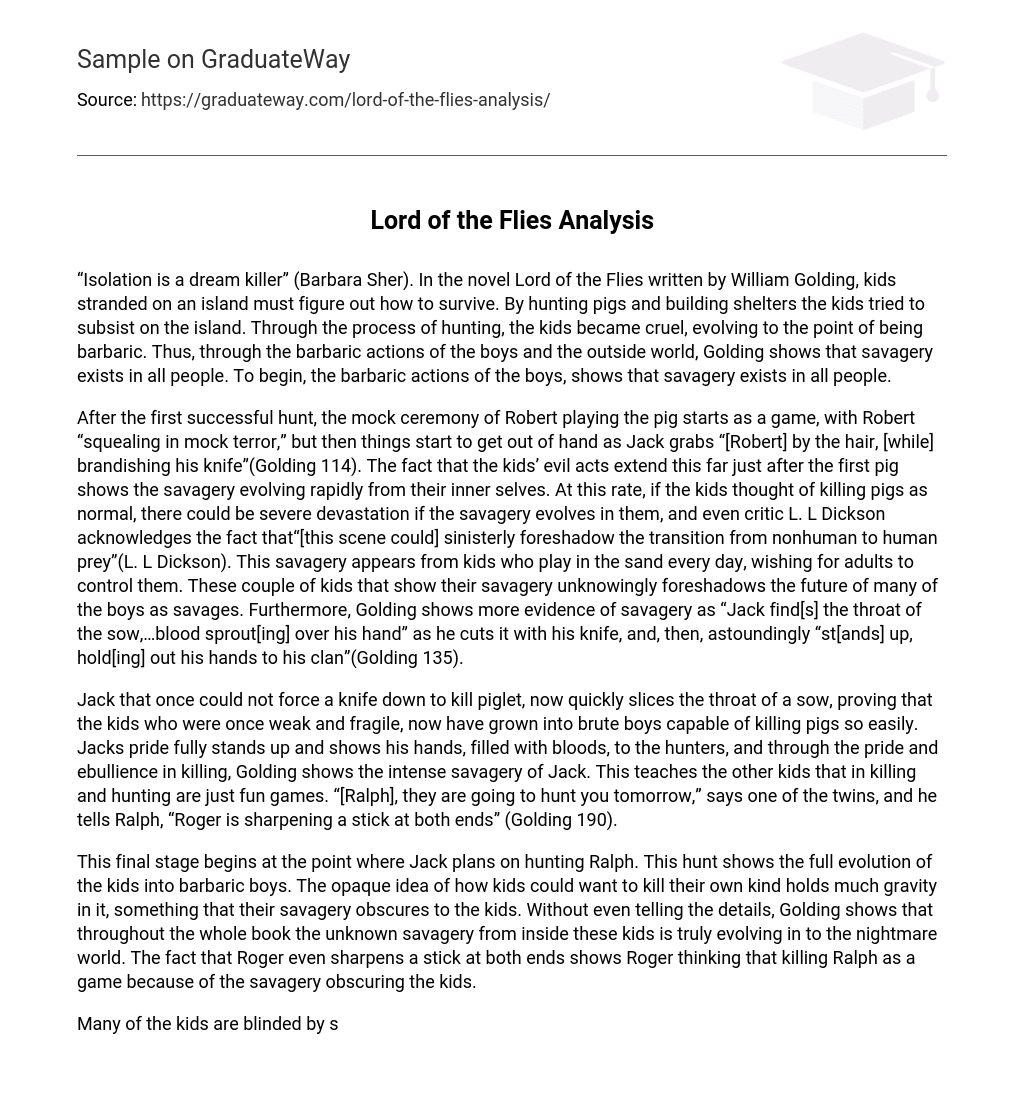“Isolation is a dream killer” (Barbara Sher). In William Golding’s novel Lord of the Flies, a group of stranded kids on an island must learn to survive by hunting pigs and building shelters. As they engage in the process of hunting, the children’s behavior turns cruel and they descend into barbarism. Golding’s intent is to demonstrate that savagery is inherently present in all individuals, which is illustrated through the boys’ barbaric actions and their interaction with the outside world.
After the initial successful hunt, a mock ceremony ensues with Robert portraying the pig. Initially portrayed as a game, Robert is depicted as “squealing in mock terror,” but the situation quickly escalates as Jack forcefully grabs him “by the hair, brandishing his knife” (Golding 114). This swift progression of evil acts following their first pig hunt reveals the rapid evolution of savagery within the children. If the children already consider killing pigs as normal, the consequences could be devastating if their savagery continues to grow. L.L Dickson acknowledges that this scene ominously foreshadows the shift from nonhuman to human prey (L.L Dickson). Despite their daily play in the sand and desire for adult control, these few children unknowingly foreshadow the future savagery of many of their peers. Furthermore, Golding presents further evidence of savagery when Jack finds and cuts the throat of a sow, resulting in blood spouting over his hand. Astonishingly, he then stands up and extends his blood-covered hands to his tribe (Golding 135).
Jack, who was previously unable to bring himself to kill a piglet, now effortlessly slaughters a sow, demonstrating the transformation of once weak and fragile children into brutal boys capable of easily taking the lives of pigs. Jack proudly shows his bloody hands to the hunters, showcasing his savage nature and enthusiasm for killing. Through this display of pride and exhilaration in killing, Golding highlights the intense savagery within Jack. This serves as a lesson to the other children, teaching them that hunting and killing are merely games of enjoyment. One of the twins warns Ralph that they will hunt him down the next day, adding that Roger is preparing a dangerous weapon by sharpening a stick from both ends (Golding 190).
At this final stage, Jack’s plan to hunt Ralph marks the complete transformation of the children into barbaric boys. The concept of children wanting to kill their own kind carries great weight, a disturbing reality obscured by their savagery. Without explicitly elaborating, Golding illustrates how the unknown savagery within these children progressively spirals into a terrifying nightmare. The fact that Roger sharpens a stick at both ends signifies his view of killing Ralph as a mere game, a product of the savage influence clouding the children’s minds.
In this passage, Golding demonstrates that savagery is present in all individuals through various actions and events. The children’s pursuit of Ralph showcases their blinded state, consumed by the primitive instinct of hunting. Robert’s injury inflicted by his own peers exemplifies the barbaric nature that has overtaken them. Furthermore, the ruthless killing of the sow further emphasizes the ferocity residing within them. Alongside these acts, Golding also highlights the presence of savagery through the consequential hunt for Ralph. Moreover, the author suggests that the effects of war in the outside world contribute to the existence of savagery in all people.
The plane full of children “was [under attack],” and as Piggy looks out the window, he sees “fire [escaping] from [the plane]” (Golding 8). Golding uses this incident to demonstrate the human desire for destruction. This desire for destruction is further evident when Jack sets fire to the island in his pursuit of Ralph. Through these acts of destruction, Golding acknowledges the presence of savagery within humanity. One might believe that humanity is superior and inherently good, but in reality, humans are the most destructive species in Earth’s history.
In addition, amidst the airborne battle, the sky is abruptly illuminated by a sudden bright explosion. As a result, a figure with limbs hanging down descends swiftly beneath a parachute (Golding 95). Golding employs this individual with dangling limbs to depict the impact of war, which is one of the most formidable forces of devastation. The yearning and aspirations of the people give rise to warfare, wherein savagery exerts such profound control over an individual that they take extreme measures to fulfill their desires. This inclination towards war is exemplified when individuals enlist in the military out of the craving and pride associated with taking lives, thereby unveiling the inherent savagery that resides within humanity.
At the conclusion, the boy is rescued by a naval officer who stands on the sand and gazes at the trim cruiser, a weapon of great destruction (Golding 202). The naval officer, filled with disgust and sorrow, looks upon the cruiser, symbolizing the transformation of the once British boys into savages. However, the naval officer himself becomes engrossed in the brutal world of international warfare, revealing the true nature of humanity as savages (L. L. Dickson). Golding demonstrates that savagery exists within all individuals by acknowledging the presence of war and its effects on society.
Overall, the boys’ attempt to kill Ralph serves as a clear display of their transformation from innocent children to savage beings, a transformation catalyzed by their association with Jack and his group of hunters. This savagery extends beyond the confines of the island and is reflected in mankind’s innate impulse for destruction, as portrayed by Golding through the depiction of wars. Thus, this novel serves as a reminder that savagery lies within all of us, yet it can be controlled and suppressed by our desire for goodness and working towards the greater good. Ultimately, the novel suggests that the destructive nature of isolation can be resisted and overcome.





